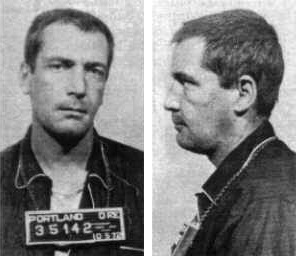Gary Gilmore facts for kids
Quick facts for kids
Gary Gilmore
|
|
|---|---|

Portland Police Bureau mugshots
|
|
| Born |
Faye Robert Coffman
December 4, 1940 McCamey, Texas, U.S.
|
| Died | January 17, 1977 (aged 36) Utah State Prison, Draper, Utah, U.S.
|
| Cause of death | Execution by firing squad |
| Criminal status | Executed |
| Parent(s) | Frank Gilmore Sr. (father) Bessie Gilmore (mother) |
| Relatives | Mikal Gilmore (brother) |
| Conviction(s) | First degree murder Armed robbery (3 counts) Assault (2 counts) |
| Criminal penalty | Death |
| Details | |
| Victims | Max Jensen Bennie Bushnell |
| Date | July 19 & 20, 1976 |
| State(s) | Utah |
| Location(s) | Orem Provo |
|
Date apprehended
|
July 21, 1976 |
Gary Mark Gilmore (born Faye Robert Coffman; December 4, 1940 – January 17, 1977) was an American criminal who gained international attention for demanding the implementation of his death sentence for two murders he had admitted to committing in Utah. After the U.S. Supreme Court upheld a new series of death penalty statutes in the 1976 decision Gregg v. Georgia, he became the first person in almost ten years to be executed in the United States. These new statutes avoided the problems under the 1972 decision in Furman v. Georgia, which had resulted in earlier death penalty statutes being deemed "cruel and unusual" punishment, and therefore unconstitutional (The Supreme Court had previously ordered all states to commute death sentences to life imprisonment after Furman.). Gilmore was executed by a firing squad in 1977. His life and execution were the subject of the 1979 nonfiction novel The Executioner's Song by Norman Mailer, and 1982 TV film of the novel starring Tommy Lee Jones as Gilmore.
Early life
Gary Mark Gilmore was born in McCamey, Texas, on December 4, 1940, the second of four sons, to Frank and Bessie Gilmore. The other sons were Frank Jr., Gaylen, and the writer and music journalist Mikal Gilmore. Frank Harry Gilmore (c. November 23, 1890, Lincoln, Nebraska – July 31, 1962, Seattle, Washington), a con man, had other wives and families, none of whom he supported. On a whim, he married Bessie (née Brown) (August 19, 1913, Provo, Utah – June 29, 1981, Portland, Oregon), a Mormon outcast from Provo, Utah, in Sacramento, California. Gary was born while they were living in Texas under the pseudonym of Coffman to avoid the law. Frank christened his son Faye Robert Coffman, but once they left Texas, Bessie changed it to Gary Mark. This name change proved to be a sore point years later. Frank's mother, Fay, kept the original "Faye Coffman" birth certificate, and when Gary found it two decades later, he assumed he must be either illegitimate or someone else's son. He seized on this as the reason that he and his father never got along; he became very upset and walked out on his mother when she tried to explain the name change to him.
The theme of illegitimacy, real or imagined, was common in the Gilmore family. Frank Sr.'s mother, Fay Gilmore, once told Bessie that Frank Sr.'s father was a famous magician who had passed through Sacramento, where she was living. Bessie researched this at the library and concluded that Frank was the illegitimate son of Harry Houdini. Houdini was only sixteen years old in 1890, the year of Frank Gilmore's birth, and did not begin his career as a magician until the following year. Whether Fay meant that Frank Sr.'s father was someone who would later become known as a famous magician is unknown. Mikal Gilmore, Gary's youngest brother, believes the story to be false, but has stated that both his father and mother believed it. Gary's oldest brother, Frank Jr, was the illegitimate son of Robert Ingram, who was Frank Sr's son from an earlier marriage. Ingram had a brief affair with Bessie shortly after she had married his father. Frank Sr had believed Gary was the illegitimate son.
During Gary's childhood, the family frequently relocated throughout the Western United States, with Frank supporting them by selling fake magazine subscriptions. Gary had a troubled relationship with his father, whom his youngest brother Mikal described as a "cruel and unreasonable man."
In 1952, the Gilmore family settled in Portland, Oregon. As an adolescent, Gary began engaging in petty crime. Although Gilmore had an IQ test score of 133, gained high scores on both aptitude and achievement tests, and showed artistic talent, he dropped out of high school in the ninth grade. He ran away from home with a friend to Texas, returning to Portland after several months.
Trial
Gilmore's murder trial began at the Provo courthouse on October 5, 1976, and lasted two days. Peter Arroyo, a motel guest, testified that he saw Gilmore in the motel registration office that night. After taking the money, Gilmore killed Mr. Bushnell. Gilmore's two court-appointed lawyers, Michael Esplin and Craig Snyder, made no attempt to cross-examine the majority of the state's witnesses, and rested without calling any witnesses for the defense. Gilmore protested, and the following day asked the judge if he could take the stand in his own defense, perhaps arguing that due to the dissociation and lack of control he felt at the time, he had a good case for insanity. His attorneys presented the findings of four separate psychiatrists, all of whom had said that Gilmore was aware of what he was doing and that he knew it was wrong at the time. While he did have an antisocial personality disorder, he did not meet the legal criteria for insanity. Gilmore withdrew his request. Mentioning the lack of witnesses to the shooting, Esplin asked the jury to find Gilmore guilty of second degree murder or even acquit him. On October 7, the jury retired to deliberate and by mid-day, they had returned with a guilty verdict for first degree murder. Later that day, the jury unanimously recommended a death sentence due to the special circumstances of the crime.
Gilmore chose to not pursue habeas corpus relief in federal court. His mother, Bessie, sued for a stay of execution on his behalf. In a five-to-four decision, the US Supreme Court refused to hear his mother's claim. The Court's per curiam opinion said that the defendant had waived his rights by not pursuing them. The execution was set for November 15 at 8:00 a.m.
Against his expressed wishes, Gilmore received several stays of execution through the efforts of the American Civil Liberties Union (ACLU). The last of these occurred just hours before the rescheduled execution date of January 17. That stay was overturned at 7:30 a.m., and the execution was allowed to proceed as planned. At a Board of Pardons hearing in November 1976, Gilmore said of the efforts by the ACLU and others to prevent his execution: "They always want to get in on the act. I don't think they have ever really done anything effective in their lives. I would like them all—including that group of reverends and rabbis from Salt Lake City—to butt out. This is my life and this is my death. It's been sanctioned by the courts that I die and I accept that."
Execution
Gilmore was executed on January 17, 1977, at 8:07 a.m. by firing squad at Utah State Prison in Draper, Utah.
Representation in the media
As Gilmore was the first person in the United States executed since the reinstatement of the death penalty in 1976, his story had immense cultural resonance at the time.
Before his execution, the December 11, 1976, episode of NBC's Saturday Night Live (Season 2, Episode 10) featured guest host Candice Bergen and the cast singing a Christmas-themed medley entitled "Let's Kill Gary Gilmore for Christmas." Dressed in winter attire and surrounded by fake snow, the performers sang the medley of familiar Christmas carols with altered lyrics.
The founder of advertising agency Wieden+Kennedy, Dan Wieden, credits the inspiration for his "Just Do It" Nike slogan to Gilmore's last words.
Norman Mailer wrote a novel, The Executioner's Song, based on Gilmore's life; it won the Pulitzer Prize. Notable for its portrayal of Gilmore and the anguish surrounding the murders he committed, the book expressed Mailer's thinking about the national debate over the revival of capital punishment.
In 1982, The Executioner's Song was adapted by Mailer for a television movie of the same name starring Tommy Lee Jones as Gilmore, and co-starring Christine Lahti, Eli Wallach, and Rosanna Arquette. Jones won an Emmy Award for his portrayal of Gilmore.
Artist Matthew Barney's film Cremaster 2 (1999), featured Gilmore as the main character, played by Barney; it was the second of five films in the series The Cremaster Cycle. At the beginning of Cremaster 3, a metamorphosed character corresponding to Gilmore is played by Nesrin Karanouh.
Gary's brother Mikal Gilmore, an American writer and music journalist, wrote a memoir in 1994 entitled Shot in the Heart, detailing his relationship with Gary and their often troubled family, starting with the original Mormon settlers and continuing through to Gary's execution and its aftermath. Shot in the Heart received positive reviews, including a comment by New York Times critic Michiko Kakutani calling the book "Remarkable, astonishing... Shot in the Heart reads like a combination of Brothers Karamazov and a series of Johnny Cash ballads... chilling, heartbreaking, and alarming." In 1994 Shot in the Heart won the Los Angeles Times Book Prize and the National Book Critics Circle Award. In 2001, Shot in the Heart became an HBO film starring Giovanni Ribisi as Mikal, Elias Koteas as Gary, Sam Shepard as the brothers' looming father, and Lee Tergesen as Frank Gilmore Jr. The 1977 punk rock single "Gary Gilmore's Eyes" by the band the Adverts was used in the soundtrack of the movie. The song is written from "the point of view of a hospital patient who has received the eyes of Gary Gilmore in a transplant." In 2003, American alternative rock band ArmsBendBack released a song titled "Gary Gilmore's Eyes" as well.
Welsh playwright Dic Edwards dramatised Gilmore's life in his 1995 play Utah Blue.
See also
- Capital punishment in the United States
- Capital punishment in Utah
- The Executioner's Song
- John Albert Taylor
- List of people executed in Utah


